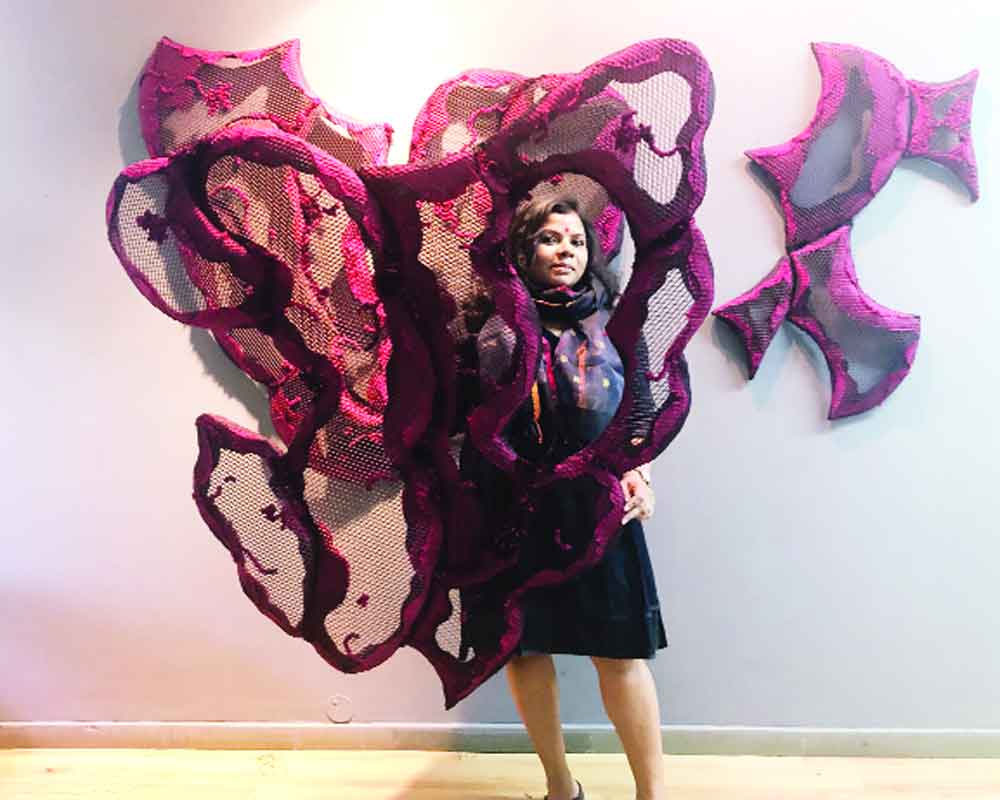Artist Pranati Panda’s exhibition Speaking Threads explores landscapes and human organs in sculpture, prints and paintings. By Sakshi Sharma
Threads, knitting and net are intertwined for the exhibition Speaking Threads. Through it, Pranati Panda explores landscapes and human organs in sculpture, prints and paintings which she fondly refers to as ‘time pieces’.
Pranati wanted to have a confluence of two energies. So she used both, what she perceives as ‘feminine’ materials such as thread and fabric alongside ‘masculine’ materials such as net and jaali. Said she, “I grew up watching my mother knit so I was very clear that I wanted to use it. I particularly used nets in my brain work because in our country women still need freedom and jaali symbolises a cage that they are trapped in. Though we suppress our feelings and emotions and don’t talk freely about them but we want to be free from all the atrocities.”
As a mother and a woman, I have gone through many expereiences in my life. And this is what I wanted to reflect in my paintings,” said artist Pranati Panda. Why did you choose thread as the core element for your work? Said Pranati, “They connect one idea to another, or maybe one idea to many and vice versa. They can hold the masculine and feminine energy together. And the best part is that they are seamless, there is no narration of time. Ideally that is what life is. There couldn’t have been a better material than this to describe my journey.”
Much of Pranati’s oeuvre continues to be driven by self-analysis, her experiences and philosophies. Often when an exhibition revolves around one person’s experiences, it doesn’t necessarily interest everyone. But she feels that though each one of us lead our lives differently, we are very connected. Every human goes through similar emotions in different phases of life. Even the objects, nature and the outer world is connected to each other as human reactions have a direct impact on the outside world. So she believes that people will be able to connect closely with her work.
Known as the father of neuroscience, Dr Santiago Raman has been her source of inspiration as his work and journey fascinated her. Apart from him, the everyday ordinariness that she witnesses around her inspires her too. “I learn from every moment and person. Not only that, I even learn from my dog because he loves me without any expectations. I learn from my maids too. When I talk to them I feel that they have similar desires in life. The only difference is that they feel it is hard or nearly impossible to accomplish them,” said she.
She was keen to showcase the brain sculptures as the organ is the powerhouse of thoughts. So it governs our ideation process, everyday activities and relationships.
Most of her work has rampant use of red, which represents blood and life force. When questioned about the overpowering colour, she shared an incident about the loss of her first child while giving birth. And the artist somehow still lives with that particular moment. She said, “Not only this, I connect to this colour because of other reasons too. I belong to Odisha, where we believe that when you wear anything red, you find your soulmate. And my mother always used to put a big red bindi, sindoor and wear red bangles. So while growing up, I have seen it all around. Even today I wear something or the other which is red. Maybe a bindi or a bangle. For me this colour is my life energy.” She added that she lost her mother at a very young age. And when she closes her eyes, the first thing that grabs her attention is the colour. For her, it symbolises her mother’s presence or maybe her bindi.
This absence played a huge role in her works as three to four of them were titled, Essence of absence which reminds her of her child and her mother’s presence.
Other than this, some paintings even seemed inspired by nature. The artist expressed her love for nature since childhood as she had spent most of her early life in village. Said she, “My childhood was very colourful. I have seen both village and city life. So I have always been very close to nature and animals. Even today I love spending time with plants and talking to them as they have similar emotions.” But she feels that the hassles of so-called modern life have taken those small joys away. Now the intensity between humans and nature is less.
Pointing towards a painting with layers of white thread she said, “They depict my hidden emotions, some pleasant, some unpleasant.”
(The exhibition is on till January 15, 2020 at Vadehra Art Gallery.)
























